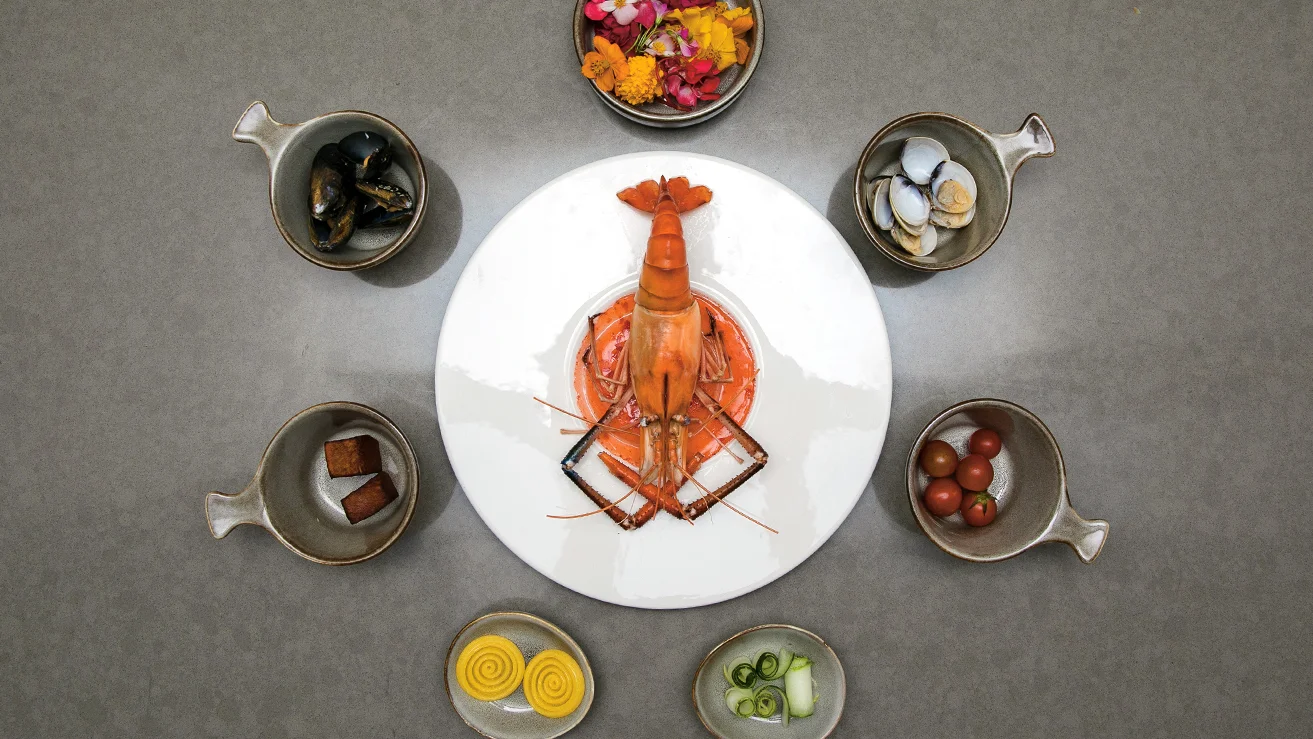How to Win at Cooking: Chef Rhea Gilkes of Fusion Rooftop
Chef Rhea Gilkes’ classic French, Italian and Asian dishes incorporating local ingredients are as impressive as the open-air restaurant itself, complete with a living wall, marble-topped sushi counter, dark slate couches, and an exterior patio overlooking Holetown and the turquoise waters beyond.
— By Amie Watson
— Photography: Kenneth Theysen
Rhea Gilkes
Chef – Fusion Rooftop
The moment you step out of the elevator into the chic rooftop restaurant above the Limegrove Lifestyle Centre, you feel a gentle breeze that turns the white drapes into billowing sails. A glass-walled wine room adds elegance while succulents in rock-filled planter boxes delineate seating areas in the spacious setting, creating a feeling of zen. Diners dig into local black belly lamb shanks with risotto tinged bright yellow by fresh turmeric root; tuna tartare with a whisper of heat; and succulent piri-piri Caribbean shrimp with avocado purée, zucchini-wrapped asparagus, pea shoots, cucumber, pickled radishes and mango gel. Others dip rainbow rolls made with the same local tuna into soy sauce.
The woman behind the restaurant’s culinary success (and our co-cover chef) is Rhea Gilkes.With a couple of university degrees, a handful of debating awards, and a slew of culinary victories and television appearances under her apron, she’s a veritable tour de force. She’s also a lovely person, with a tendency to touch her nose when thinking, an endearingly dark sense of humour, and a playful joy when talking about food. She stepped out of her kitchen to do just that.
How does your menu combine different cuisines?
My early training was in classic French techniques. At Fusion, we have a sushi bar, and also an Italian and an Asian side of the menu, with wok dishes and curries, but rather than mixing everything together, I wanted us to have a French-Asian vibe, which allowed me to train staff and have an identity emerge.
How does your menu integrate local produce?
Though a dish might be instantly recognisable to a world traveller, it will be made with local ingredients, like local black belly lamb with risotto made with fresh turmeric grown here. Sixty per cent of that dish is sourced locally. It just makes sense because it’s less expensive and you taste the difference. We do import some of the Asian products for authenticity, like real wasabi, which we can’t get here, but the tuna is very fresh and local.
How did you become involved with Slow Food Barbados?
Food Barbados announced an Iron Chef competition in May 2014 and I love competitions. I got there and there was this table with a spectacular array of organic foods grown in Barbados. I was astonished, because there were striped radishes and things I’d never seen here. And I won! And took my prizes and ran off home. But I missed the Slow Food guys, so I met up with Ian and Julie McNeel and John Hunte who started the Slow Food movement here. This is where my interest in food and my interest in politics and development intersected. My political activism is now expressed through what I choose to cook and how I choose to cook it. I’m more aware of what’s sustainable and how our spending choices affect our economy and tourism industry.
What are some of your favourite local products?
We get cheese from Hatchman’s Cheeses; lettuce from Archer’s Organics; microgreens from Ino-Grow; and vegetables from farmers like Joanna Waterman of Cane View Organics and John Hunte. He created a WhatsApp group for Barbados organic farmers, so I basically have all the local organic farmers in my pocket. They’ll say, “I have this, do you want it?”. Or I ask if anybody has something and they’ll reply. I also get bacon, lamb shanks and really good quality pork from my local butchers, Boulevard Butchers and Clifton Meats.
What’s jamoon, as in your jamoon and blueberry vinaigrette?
It’s a local fruit that looks like a bit like a blueberry. When it was in season, we got a huge batch and sat it in the fridge until the flesh fell off. It has a seed in the middle and a taste that’s a little tart, a little sweet, and a little astringent – it ties your mouth up. The purple colour is spectacular. We use it for our cassava-crumbed goat’s milk cheese salad with organic greens, roasted garlic, pickled carrots and beets.
What other chefs have inspired you?
There were two weeks when Nobu came to Sandy Lane and I learned a lot about sushi. And after an epic nine-course tasting menu at Toqué! in Montreal, I met Chef Normand Laprise. Turns out he has a Barbadian chef at his sister restaurant, Brasserie T!, so I did a two-week stage there in 2017.
Where else have you trained?
There’s this program where Barbadians can go to Canada and work for six months. So I went to Ontario to work at Wildfire at the Taboo Resort. They were doing cutting edge daily tasting menus. Then I worked at The Rosseau at the JW Marriott property in Muskoka.
Which do you prefer: sushi or grilled fish?
Sushi. I think raw fish has more subtle flavours. And I love the combination with rice, which is probably my favourite grain on earth. My favourite roll is the Eclipse because it’s deep-fried. No! The Rainbow Roll because it’s got all the different fish on the outside, and there’s avocado in the middle and shiitake-infused mayo.
Fusion
Fooftop
Limegrove Lifestyle CentreHoletown
St. James
(246) 271-1258










